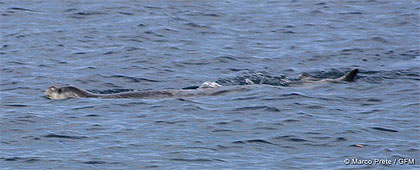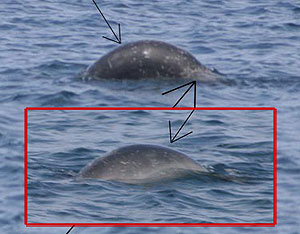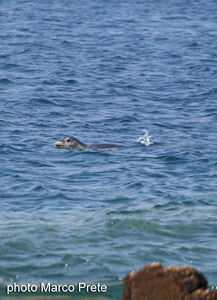Letters to the Editor
The last issue of TMG included a “photo quiz” promoted by the Italian Monk Seal Group – Gruppo Foca Monaca: the photo was one out of 41 shots taken by a tourist from a low cliff near the tower of Campese, on the north-western part of Giglio, and the marine mammal was at about 20 meters distance from the coast. The sighting lasted for more than half an hour, and other people were present. TMG staff comment was very clear: “As far as TMG is concerned… we think we see two seals (to judge from the stretched appearance and the subtle foreground shape…)”.


I would like here to give my personal evaluations to the event. As GFM, we made an accurate evaluation of the photo (including all the others), and we reached the same conclusion: the presence, at the same moment and in the same place, of two animals, something that was not at all noticed by the photographer.
One of the two seals was sighted many times (approx. 10), from 11:58 up to 12:35. The photos were taken in this lapse of time with a professional Canon, using a 200 mm zoom, and with 3 shots/second setting.
The animal looked very disturbed, raising the head out of the water, a behaviour clearly visible in the photo no. 1, the first of seven shots, where the sixth (photo no. 2) shows how the seal was looking towards “something” just behind, and not towards the observers that were standing up on the cliff.

A second sequence of three shots (11:59) shows the second seal diving (photo no.3): it is possible to notice the difference from the first seal looking at the skin colour, much darker (typical of adult males). Have a look at the insets included in the same picture: the colour is much lighter.
Several shots, including the one featured in the “photo quiz”, show the lighter seal together with a part view of hind flippers, placed in a position impossible to be its own: the most likely explanation is that the other seal was just underneath, trying to catch her: a behaviour suggestive of courtship.

Finally, within the lapse of time between the first and the last picture, the lighter seal did not move away from the cliff, but – as it is shown in the last photo (photo no. 4) – she came closer, further confirming that she did not care very much about the people watching her from the rocks.
If I can add some further considerations to the description of the behaviour of such a still rather unknown species, (I guess somebody could define it as enriched by personal “insights”), I must admit that I was a bit frustrated by the fact that there were no other notes or comments to the “photo quiz”, apart from the one of TMG. This aspect can be assumed as a clear symbol of the lack of ideas or information exchange among the community dealing with monk seal study and conservation. I am personally convinced that monk seals can be saved only through a sincere and clear exchange of ideas and information among all those involved in their conservation. I unfortunately learned, on several occasions, that this does not happen at all, and this “behaviour” often involves those that work “professionally” on the issue. The reasons for such “scientific discretion” can vary and are sometimes understandable, but we should not forget that the monk seal is one of the rarest species on earth, and any information, even partial, is extremely important for the conservation community, to improve the protection.
— Emanuele Coppola – Gruppo Foca Monaca Italia
Photo gallery containing all the photos from Giglio: http://www.naturaindiretta.com/gfm/giglio/index.htm
TMG replies: After making comparisons with other photographs of adult female Mediterranean monk seals TMG had to reverse its opinion that “we think we see two seals” in the picture of the “photo quiz”. Comparing pictures, we thought it much more likely that it shows just one animal. Also now, after finally seeing all the pictures in the gallery, we see no convincing evidence to the contrary. — Matthias Schnellmann

We must consider that one animal placed in horizontal way (more and less) in any frame could appear shorter but never longer. In the photo number 8784 the seal is too long! If you measure the ratio between the lenght of face and the lenght of all body in the accurate drawing of Samaranch and Gonzales (2000) you can note that the ratio is more and less 0.15. In the photo 8784 the ratio is 0.083. I think that this difference is too big! I invite you to measure the ratio. I am sure that in the photo 8784 there are two seals! – Andromeda De Gioia, Phd student on Mediterranean monk seal.
Samaranch and Gonzales, 2000. Changes in morphology with age in Mediterranean monk seals (Monachus monachus). MARINE MAMMAL SCIENCE. VOL. 16. NO. 1:141-157.
Thank you Andromeda, your contribution will be helpful. My description includes many other interesting details, not all of them fully visible in the low res photogallery, like air bubles on the side of the grey seal.
Nevertheless I insist to drive readers attenction to the behavior aspect, because my description gives an interpretation of what could be happening underwater during those 40 minutes in which the animals, mainly the grey one, were visible by tourists. On the contrary the simple sentence like the last one from TMG just leaves the fact as it is: “shows just one animal” …. with no reason why this single seal would be spending so long time in that specific place, so near to peple watching.
This is not a simple matter of numbers, because my interpretation means also breeding activity in that area, while this is not considered to be possible by the whide scientific community. In fact this would be in contrast with the well accepted theory that Mediterranean monk seal can only survive in the Eastern Mediterranean.
The theory is based on the fact that no seal pup or nursing seal was observed in Italy, Sardinia and Sicily (like if those island are not part of Italy itself !!) in the last30 years and fot this reason the seal is considered extinct in those territories.
Nobody mentioned the fact that no research was ever conducted with appropriate methods in those areas.
I hope other comments will be sent to this issue, because as I already said, exchange of opinions could be a vary helpfull process for the best knowledge of the monk seal.
Speaking in general of observation and recognition of species of wildlife, I would like to focus on one aspect in my opinion important, and that is how in absence of ideal conditions (which do not occur in nature, however, hardly ever, much less in sea where the observer is out), the conclusions often are drawn from a set of factors do not always definable, but generally contribute to a good sighting, at least in terms of probabilities. In this case, the trial must be based on a series of still images whose objective aspect is (for us) only what is clearly seen in part out of water. As we talk about seals in the water, it is understandable that, since two seals in the courtship, the resulting pictures show a number of issues that need to grasp, just because they occur below the surface, which makes up the circumstances if not certain, at least highly likely. The face and body length ratio evidenced by Andromeda is perhaps the most striking element of a single photo (as well as the 8761 shooting, in which really seems to be another individual), but considering the images from a global point of view, and other details reported on the behaviour (..the animal looked very disturbed..) it is overall the attitude of the likely female to convince (invitation to look well sequence from 8772 to 8775); a video of course would solve any reasonable doubt … but we can’t expect that two seals dating in water poses out of the water itself for a photographer, who is unexpectedly to capture the event.
Certo è molto difficile pensare che in tutto quel tempo la testa della seconda foca non sia comparsa in contemporanea, però è legittimo pensare che quella foca non sia nata in Tunisia o addirittura in Grecia. Probabilmente il nucleo sardo negli anni settanta era ben più numeroso di quello rilevato da Furreddu di soli 4/5 elementi che ruotava intorno alla grotta del Fico. L’avvistamento di Castelsardo di pochi anni fà ne è la testimonianza. Quindi propendo per le teorie di Emanuele aldilà del Giglio, e anche Portofino insegna che qualche cosa ci sfugge. Nessuna ricerca organica è stata fatta, ci si è seduti sui dati di Furreddu che probabilmente per il forte amore per la speleologia si limitava al Golfo di Orosei, ma la morte del cucciolo di capo Marargiu nel 1984 conferma che qualche cosa sfuggiva e anche in seguito a quel ritrovamento nessuna indaggine fu fatta, eppure in quel periodo Furreddu era ancora in vita.
In Sardegna la quantità di foche presenti nei primi anni ottanta era probabilmente ancora consistente e questo giustifica la presenza di alcuni individui ancora oggi dato che la vita media di un foca in natura è di 15/ 20 anni.